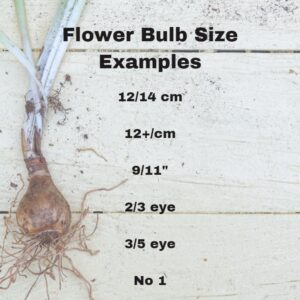If you are brand new to gardening with flower bulbs you have come to the right place. When shopping online for flower bulbs and bare-root perennials size information can be confusing or vague at first. However, by learning what different flower bulb sizes mean, why some bulb sizes look different than others, and the importance of bulb size you will be a better flower bulb shopper. If you are an experienced gardener don’t stop reading as we hope to be able to clear up any questions you have about flower bulb sizes as well.
Flower Bulb Size Basics
What are the different ways flower bulb sizes are listed?
Flower bulb sizes can be listed in units such as centimeters, or inches. Due to the large amount of flower bulbs grown in Holland measuring the bulbs in centimeters is most common. However, bulbs such as Elephant Ears which widely come from Costa Rica are measured in inches. 
Not all flower bulbs are measured by numerical units, some bulb sizes are listed by the number of eyes the bulb has. The eyes are the point where the growth will come from on the bulb. Canna lilies and peonies sizes are listed by the number of eyes the bulbs have. More eyes on a rhizome will produce a more vigorous plant.
Flower bulbs and perennials sizes can also be listed by grade. Bare root perennials sizes are almost always sold by grade. The grade is based on the age and size of the roots. Grade number 1 is the most common size sold by retail outlets. If an item is listed as the No 1 grade on the website you are shopping on, it means it is the largest size available for that item that season.
When it comes to perennials that are sold as No 1 Grade it can be confusing to know what size you are getting. This is because perennials vary greatly and some have large root systems like daylilies and iris. Other perennials such as toad lily, coneflower, and black-eyed susan tend to have small delicate root systems. This guide to planting bare root perennials shows the difference in several popular perennial varieties.
How are flower bulbs measured?
Bulbs that are sold by centimeters are measured in circumference. If you need a math refresher circumference is determined by measuring around the outside of a circle. In the case of the flower bulb, it is the measurement of the widest part of the flower bulb. One exception to this is how begonia tubers are measured. They are measured across the top of the bulb in centimeters, not around the bulb like most other times.

The metric system is not the standard unit of measurement in the United States, therefore, visualizing the size of bulbs can be difficult for some people. Listed below are some common bulb sizes compared to everyday objects.
- 7-8 centimeter bulb is approximately equal to the size of a Milk Dud or Junior Mint candy
- 11-12 centimeter bulb is approximately equal to the size of a golf ball
- 20-22 centimeter bulb is approximately equal to the size of a tennis ball
Now that you have some common objects to compare some bulb sizes to, it should be easier to get an idea for other bulb sizes as well. If these visualizations aren’t helping and you are used to working with inches vs centimeters convert the centimeters to inches. 1 centimeter is equal to .39 inches. Therefore, if you have a 10 cm bulb and multiply it by .39 you will learn the circumference of that flower bulb in inches is 3.9″.
How important is flower bulb size?
The bigger the bulb the bigger the bloom is the general rule of thumb when it comes to flower bulbs. Different varieties of flower bulbs also play a role in flower size. For example, Darwin Hybrid Tulips and Fosteriana Tulips generally have larger blooms than Triumph Tulips, even when the bulbs are the same size. However, if you are deciding between two packages of the same exact flower bulb and the only difference is the bulb size the larger bulb size will produce a larger bloom. 
While the largest blooms always seem like the go-to option there are times when purchasing a smaller bulb makes sense. When mass planting tulip or daffodil bulbs in groups of hundreds or thousands in an area, using small bulbs often makes sense. The price per bulb is considerably less in bulk tulip and daffodil packs. If you need a large quantity this savings can go a long way. Due to the volume that is being planted, it creates a massive display of color. Therefore, the size of each individual bloom is not as important when bulbs are planted in mass.
How does flower bulb size relate to planting depth?
The size of the flower bulb is a guide to how deep the bulbs need to be planted. Plant the bulb 2-3 times deep as the height of the bulb. Therefore, a bulb that is 2″ tall should be planted 4-6″ deep.
All Things Grow
Regardless of the size of the bulb, even smaller bulbs grow. They may take longer to mature, however, can be an affordable option for gardeners on a budget. However, for the biggest display of blooms of your budget allows, choose the largest bulb size available for the variety you are looking at. Water, sun, and fertilizer can also impact the outcome of your blooms regardless of size. Bulb size is a factor, but not the only one when it comes to the ultimate display of blooms.


